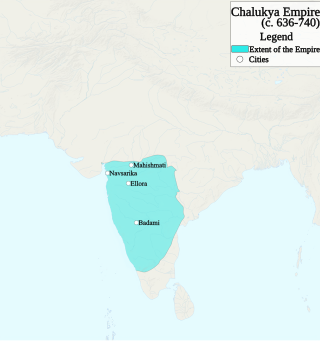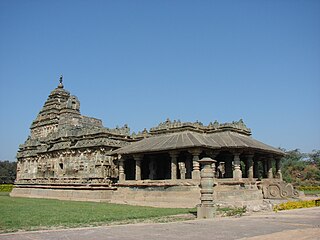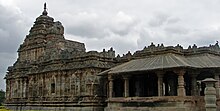
Amoghavarsha I was an emperor of the Rashtrakuta dynasty, and one of the most notable monarchs of Early Medieval India. His reign of 64 years is one of the longest precisely dated monarchical reigns on record. Many Kannada and Sanskrit scholars prospered during his rule, including the great Indian mathematician Mahaviracharya who wrote Ganita-sara-samgraha, Jinasena, Virasena, Shakatayan and Sri Vijaya.
Pulakeshi II popularly known as Immaḍi Pulakeśi, was the greatest Chalukyan Emperor who reigned from Vatapi. During his reign, the Chalukya Empire expanded to cover most of the Deccan region in peninsular India.
The migrations of people and influences to the North from Karnataka during 7th-12th century period is well attested by the sources but has not yet been studied carefully. This is known as "The Great Karnataka expansion"

Lakkundi, also referred to as Lokkugundi, was a major city before the 14th century, and is now a village in Gadag District of Karnataka, India. By 10th century, it was already a major economic and commerce center with mint operations for South India, one mentioned in Kannada and Sanskrit inscriptions and texts. By 12th century, many Hindu and Jain temples had been consecrated here, along with public infrastructure such as stepwells and water reservoirs. Among the major temples are the Brahma Jinalaya (oldest), Mallikarjuna, Lakshminarayana, Manikeshwara, Naganatha, Kumbheshvara, Nanneshwara, Someshwara, Narayana, Nilakanteshwara, Kasivisesvara, Virabhadhara, Virupaksha, and others. As its importance and wealth grew, Lakkundi became one of the capitals of the Hoysala Empire.

Eastern Chalukyas, also known as the Chalukyas of Vengi, were a dynasty that ruled parts of South India between the 7th and 12th centuries. They started out as governors of the Chalukyas of Badami in the Deccan region. Subsequently, they became a sovereign power, and ruled the Vengi region of present-day Andhra Pradesh until c. 1001 CE. They continued ruling the region as feudatories of the Medieval Cholas until 1189 CE.

Tailapa II, also known as Taila II and by his title Ahavamalla, was the founder of the Western Chalukya Empire in peninsular India. Tailapa claimed descent from the earlier imperial Chalukyas of Vatapi (Badami), and initially ruled as a Rashtrakuta vassal from the Tardavadi-1000 province in the present-day Vijayapura district of Karnataka. When the Rashtrakuta power declined following an invasion by the Paramara king Siyaka, Tailapa overthrew the Rashtrakuta emperor Karka II, and established a new dynasty.

The Western Chalukya Empire ruled most of the western Deccan Plateau in South India between the 10th and 12th centuries AD. This Kannada-speaking dynasty is sometimes called the Kalyani Chalukya after its regal capital of Kalyani in present-day Basavakalyan, Bidar district, Karnataka, and the Later Chalukya from its theoretical relationship to the sixth-century Chalukya dynasty of Badami. It is known as the Western Chalukyas to distinguish it from the contemporaneous Eastern Chalukyas of Vengi. Before the rise of the Chalukyas, the Rashtrakuta Empire of Manyakheta controlled most of the Deccan Plateau and central India for over two centuries. In 973, seeing confusion in the Rashtrakuta Empire after an invasion of their capital by the ruler of the Paramara dynasty of Malwa, Tailapa II defeated his overlords and made Manyakheta his capital. The dynasty quickly gained power and grew into an empire under Someshvara I, who moved the capital to Kalyani.
Akkadevi, 1010-1064 CE was a princess of the Chalukya dynasty of Karnataka and governor of an area known as Kishukādu, situated in the present day districts of Bidar, Bagalkot and Bijapur. She was the sister of King Jayasimha II of the Western Chalukyas, and aunt of Someshvara I.

Panchakuta Basadi is a temple complex located in the Kambadahalli village of the Mandya district, Karnataka state, in southwestern India. It is one of the finest examples of South Indian Dravidian architecture of the Western Ganga variety, related to the Jain faith and iconography.

Karnataka, a state in South India has a long association with Jainism, a religion which enjoyed patronage of major historic kingdoms in the state such as the Rastrakuta Dynasty, Western Ganga, Kadamba and Chalukya dynasties and the Hoysala Empire. Today the state is home to a number of Jain monuments, such as temples, Gommata statues and stambhas.
The Western Ganga Dynasty was an important ruling dynasty of ancient Karnataka. Its members are known as Western Gangas to distinguish them from the Eastern Gangas who in later centuries ruled over modern Orissa. The Western Gangas ruled as a sovereign power from the middle of fourth century to middle of sixth century, initially from Kolar, later moving their capital to Talakad on the banks of the Kaveri River in modern Mysore district. Though territorially a small kingdom, the Western Ganga contribution to polity, culture and literature of the modern south Karnataka region is considered noteworthy. The Ganga kings showed benevolent tolerance to all faiths but are most famous for their patronage towards Jainism resulting in the construction of fine monuments in such places as Shravanabelagola and Kambadahalli.

The Kasivisvesvara temple, also referred to as the Kavatalesvara, Kashivishveshvara or Kashi Vishvanatha temple of Lakkundi is located in the Gadag district of Karnataka state, India. It is about 12 kilometres (7.5 mi) from Gadag city, between Hampi and Goa. The Kasivisvesvara temple is one of the best illustrations of fully developed Kalyana Chalukya style of Hindu architecture.

Jainism in North Karnataka flourished under the Chalukyas, Kadamba, Rashtrakutas, and Vijayanagara Empire. Imbued with religious feeling, patronage was extended towards the building of Jain temple and it garnered high repute among the people, particularly the ruling classes and the mercantile community; effectively getting treated as the state religion.

The Chalukya dynasty was a Classical Indian dynasty that ruled large parts of southern and central India between the 6th and the 12th centuries. During this period, they ruled as three related yet individual dynasties. The earliest dynasty, known as the "Badami Chalukyas", ruled from Vatapi from the middle of the 6th century. The Badami Chalukyas began to assert their independence at the decline of the Kadamba kingdom of Banavasi and rapidly rose to prominence during the reign of Pulakeshin II. After the death of Pulakeshin II, the Eastern Chalukyas became an independent kingdom in the eastern Deccan. They ruled from Vengi until about the 11th century. In the western Deccan, the rise of the Rashtrakutas in the middle of the 8th century eclipsed the Chalukyas of Badami before being revived by their descendants, the Western Chalukyas, in the late 10th century. These Western Chalukyas ruled from Kalyani until the end of the 12th century.

The Tyagada Brahmadeva Pillar is a decorated free standing pillar, 2.3 m tall, commissioned by Chamundaraya, an important minister and commander in the Western Ganga kingdom, during the rule of King Marasimha II (963–975), Rachamalla IV (975–986) and Rachamalla V. The pillar dates to around 983 C.E. and exists on the Vindyagiri hill in the important Jain heritage town Shravanabelagola, in the Karnataka state, India. On the base of the pillar, on the north side, is an inscription in old Kannada language of the same period, which according to epigraphist and historian B.L. Rice confirms Chamundaraya's involvement in the erection of the pillar. Free standing pillars are a characteristic feature of the Western Ganga art and are broadly classified as "Mahastambha" and "Brahmastambha".

The Brahma Jinalaya, sometimes called as the Greater Jain Temple of Lakkundi, is an early 11th-century Mahavira temple in Lakkundi, Gadag District of Karnataka state, India. The temple is attributed to Attiyabbe, the wife of the local governor Dandanayaka Nagadeva. It faces east, has a mukhamandapa, a gudhamandapa and its sanctum is covered by a sur-temple style vimana superstructure. The temple is notable for its reliefs depicting Jaina artwork, statues of the Tirthankaras and the two statues of Brahma and Saraswati inside its inner mandapa.

The Nannesvara Temple, also referred to as the Nanneshvara temple, is an 11th century Hindu temple in Lakkundi, Gadag district, Karnataka. It is notable for being the earliest known imperial-style temple of the Kalyana Chalukyas, one with significant influences from both North Indian and South Indian schools of Hindu architecture. It stands immediately west to the much larger and more ornate Kasivisvesvara twin Temple in a similar style.
Munja, also known as Vakpati II, was an Indian ruler from the Paramara dynasty, who ruled the Kingdom of Malwa. He is known for consolidating the Malwa kingdom, for patronising poets and scholars and for achieving the military success against almost all of the neighbouring kingdoms.
The Chalukyas of Vemulavada were an Indian dynasty that ruled in and around the present-day Telangana between 7th and 10th centuries. Their capital was located at Vemulavada, and they were vassals of the Rashtrakutas.

The Lakshmeshwara Jain temples is a group of Jain temples in the town of Lakshmeshwara in the Gadag district of Karnataka.














